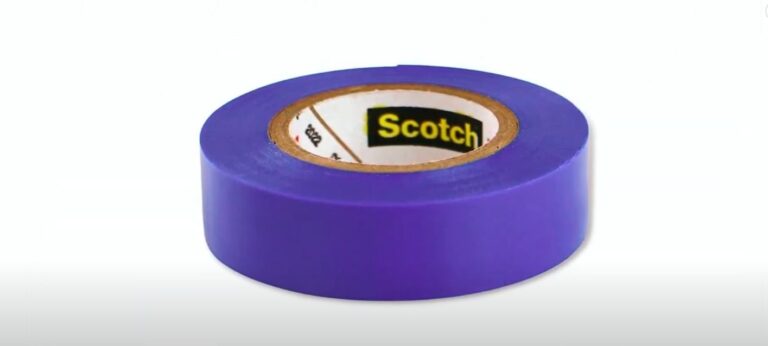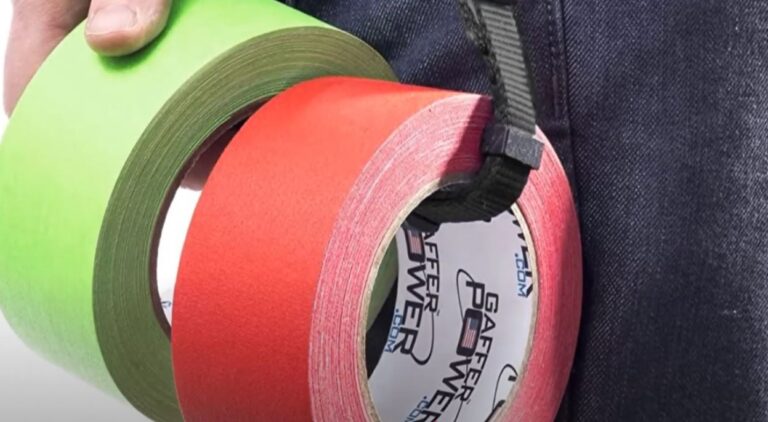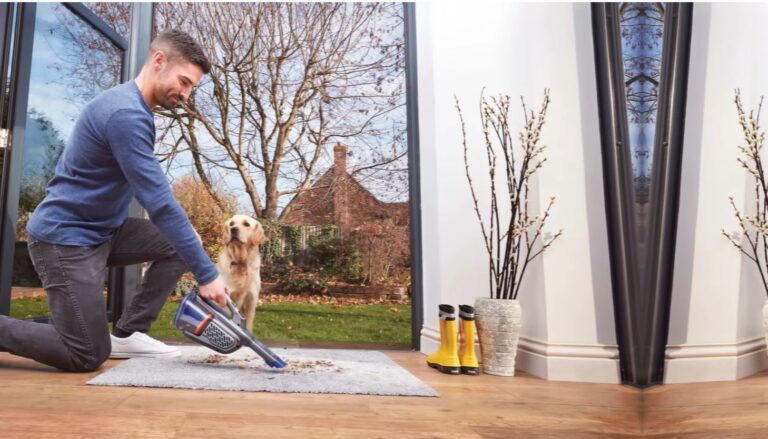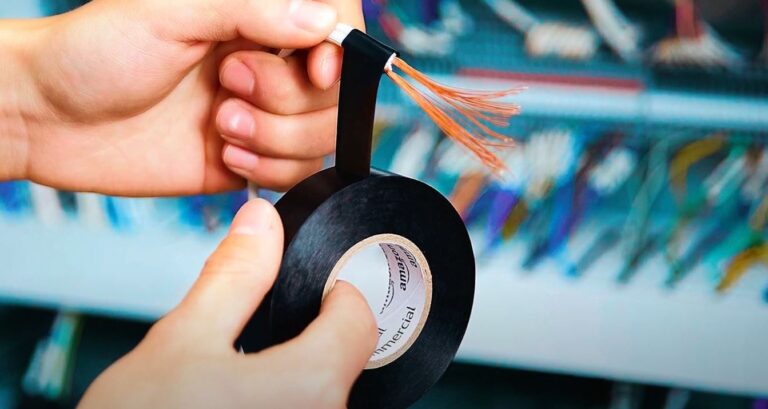How to Fix a Cut Wire with Electrical Tape (Step-by-Step Guide)
Electrical tape is a handy tool, but it’s not a magic bullet for all wiring problems. Knowing when to avoid it is crucial for safety.
- Severely Damaged or Melted Wires: If a wire’s insulation is melted, brittle, or charred, it’s a sign of a major electrical issue. Taping over this kind of damage is extremely dangerous and won’t fix the underlying problem. The wire’s core might be compromised, leading to a fire or shock hazard. In this case, the entire wire section must be replaced.
- High-Voltage Applications: Standard electrical tape is designed for low-voltage residential use. Never use it to repair wires in high-voltage systems, like those found in industrial machinery or power lines. The tape’s insulating properties are insufficient for such high voltages and could lead to a catastrophic failure.
- Long-Term Permanent Repairs: Think of electrical tape as a temporary bandage, not a permanent solution. While it can hold a repair together for a while, it’s susceptible to degradation from heat, moisture, and friction. For a durable, long-lasting fix, you need a more permanent method like heat shrink tubing or wire connectors.
Tools and Materials Needed
Before you begin, gather the right tools to ensure a safe and successful repair.
- Electrical tape (high-quality, UL-listed): Look for tape with a UL (Underwriters Laboratories) listing. This certification means it has been tested and approved for safety and insulation.
- Wire cutters/strippers: These are essential for making a clean cut and for stripping the insulation from the wire ends.
- Voltage tester: This is a non-negotiable safety tool. It allows you to confirm that the power is completely off before you touch any wires.
- Optional: heat shrink tubing for extra safety: This is a great way to reinforce your repair and protect it from the elements.
Step-by-Step Guide: Fixing a Cut Wire with Electrical Tape
Step 1 – Turn Off Power Supply
Why cutting off electricity is critical.
This is the most important step in any electrical repair. Working on a live wire can result in a severe electrical shock or electrocution. A shock can cause muscle contractions that make it impossible to let go of the wire, leading to serious injury or death. To de-energize the circuit, go to your home’s main breaker panel and flip the circuit breaker for the area you’re working on. If you’re unsure which breaker it is, it’s safest to turn off the main breaker for the entire house.
Step 2 – Inspect the Wire Damage
How to assess if tape repair is possible.
Once the power is off, take a close look at the damaged wire. A successful tape repair is only possible if the copper wire inside is intact and the damage is limited to the outer insulation. If the copper is cut, frayed, or broken, you’ll need to use a more secure method like a wire connector to rejoin the two ends. If the insulation is just a small nick or a clean cut, a simple tape wrap will suffice.
Step 3 – Prepare the Wire Ends
Cleaning frayed areas.
Aligning cut ends properly.
If the wire is cleanly cut in two, you will need to strip about one inch of insulation from each end. Be careful not to nick the copper wire. If the wire is frayed, use your wire cutters to trim the damaged section cleanly. Then, you can either twist the exposed copper ends together tightly or, for a stronger connection, use a wire nut. The purpose of this step is to ensure that the two ends make a solid, continuous electrical connection.
Step 4 – Apply Electrical Tape Correctly
Wrapping method for durability.
Overlapping layers for full insulation.
Start your tape wrap a few inches before the repair area. Wrap the tape tightly and smoothly around the wire, overlapping each layer by about half the tape’s width. This overlapping technique is crucial for creating a complete and uniform seal. Continue wrapping past the repair area for a few inches on the other side. The key is to apply enough tension to make the wrap secure without stretching the tape so much that it loses its stickiness.
Step 5 – Secure the Repair
Checking for gaps or loose tape.
Reinforcing with extra layers if needed.
After your first pass, take a moment to inspect the repair. Look for any air gaps, wrinkles, or loose sections of tape. If you find any, either re-wrap the area or add another layer of tape. A loose wrap can unspool over time, exposing the live wire and creating a major hazard. A good repair should feel solid and look smooth.
Step 6 – Test the Wire
Restoring power safely.
Testing the device or connection.
Once you are confident in your repair, go back to the breaker panel and turn the power back on. Plug in the device or turn on the light switch to test the connection. If the device works properly and there are no signs of arcing or flickering, the repair was successful. However, remember this is a temporary fix.
Tips for Better Wire Repairs with Electrical Tape
- Use black electrical tape for strong insulation: Black electrical tape is typically made from a durable, high-insulation material like vinyl. Other colors may not have the same properties.
- Apply tight, smooth wraps to avoid air gaps: Air gaps can trap moisture and weaken the insulation over time, compromising the repair.
- Avoid stretching the tape too much: Overstretching makes the tape thin and reduces its insulating properties.
Alternatives to Electrical Tape for Wire Repair
Heat Shrink Tubing
How it works.
When to use it instead of tape.
Heat shrink tubing is a superior alternative to electrical tape. It’s a special type of plastic tubing that shrinks tightly around a wire when heated. It provides a waterproof, durable, and professional-looking seal. Use it for a more permanent repair or when the wire is exposed to moisture or extreme temperatures.
Wire Connectors
Safer for long-term fixes.
Easy for DIYers.
Also known as wire nuts, these are small, cone-shaped connectors that twist onto the ends of two wires to create a secure electrical connection. They are designed for a permanent and safe splice, making them ideal for long-term fixes inside a junction box.
Professional Repairs
When to call an electrician.
Some jobs are too complex or dangerous for a DIY fix. You should always call a professional electrician if you are dealing with high-voltage circuits, your home’s main electrical panel, or if you feel uncomfortable or unsure about any part of the repair.
Mistakes to Avoid When Fixing Cut Wires
- Using regular tape instead of electrical tape: Regular tapes like duct tape or masking tape are not insulators. They can heat up and melt, creating a severe fire hazard.
- Overlapping poorly, leaving gaps: Gaps in the tape wrap expose the live wire, creating a risk of electric shock.
- Repairing live wires: This is the most dangerous mistake. Always, always, always turn off the power.
Maintenance & Monitoring After Repair
- Checking regularly for wear: Periodically inspect the taped repair for signs of wear and tear, such as unraveling, cracking, or stickiness.
- Replacing tape if it loosens: A loose tape wrap is a failed repair. Replace it immediately.
- Planning a permanent fix: Remember that electrical tape is temporary. Plan to replace the taped wire or make a permanent repair as soon as you can.
FAQs on Fixing Cut Wires with Electrical Tape
- Is electrical tape safe for all wires? No. It is designed for low-voltage, residential use only.
- Can I fix extension cords with tape? It’s not recommended. Extension cords are often under stress and can be a trip hazard, which can loosen the repair. A proper, permanent repair with a cord repair kit is the safer option.
- How long does an electrical tape fix last? It varies, but it should not be considered a permanent solution. It can last for months or even years in a stable environment, but its lifespan is unpredictable and depends on conditions like temperature, moisture, and physical stress.
Conclusion
Recap of safe steps to fix cut wires.
Reminder: electrical tape is temporary, not permanent.
Final tip: safety should always come first.
Fixing a cut wire with electrical tape can be a quick and effective temporary solution, but it requires care, knowledge, and an unwavering commitment to safety. By following the steps outlined, you can safely make a temporary repair. However, never forget that this is a stopgap measure. For a durable, long-term, and truly safe electrical system, always plan to replace the damaged wire or use a more permanent repair method. Remember, in any electrical work, your safety is the most important consideration. A moment of carelessness can lead to a lifetime of regret. Always double-check your work, and when in doubt, call a professional.






